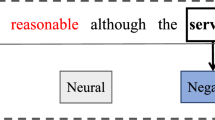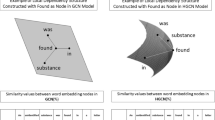Abstract
In the literature, most previous studies on English implicit inter-sentence relation recognition only focused on semantic interactions, which could not exploit the syntactic interactive information in Chinese due to its complicated syntactic structure characteristics. In this paper, we propose a novel and effective model DSGCN-RoBERTa to learn the interaction features implied in sentences from both syntactic and semantic perspectives. To generate a rich contextual sentence embedding, we exploit RoBERTa, a large-scale pre-trained language model based on the transformer unit. DSGCN-RoBERTa consists of two key modules, the syntactic interaction and the semantic interaction modules. Specifically, the syntactic interaction module helps capture the depth-level structure information, including non-consecutive words and their relations, while the semantic interaction module enables the model to understand the context from the whole sentence to the local words. Furthermore, on top of such multi-perspective feature representations, we design a strength-dependent matching strategy that is able to adaptively capture the strong relevant interactive information in a fine-grained level. Extensive experiments demonstrate that the proposed method achieved state-of-the-art results on benchmarks Chinese compound sentence corpus CCCS and Chinese discourse corpus CDTB datasets. We also achieve comparable performance on the English corpus PDTB that demonstrates the superiority of our method.





Similar content being viewed by others
References
Lin Y, Ji H, Huang F, Wu L (2020) A joint neural model for information extraction with global features. In: Proceedings of the 58th Annual Meeting of the Association for Computational Linguistics, pp 7999–8009
Yung F (2014) Towards a discourse relation-aware approach for Chinese-English machine translation. In: Proceedings of the 52th Annual Meeting of the Association for Computational Linguistics, pp 18–25, https://doi.org/10.3115/v1/P14-3003
Deng Y, Xie Y, Li Y, Yang M, Du N, Fan W, Lei K, Shen Y (2019) Multi-task learning with multi-view attention for answer selection and knowledge base question answering. In: Proceedings of the 33th AAAI Conference on Artificial Intelligence, pp 6318–6325, https://doi.org/10.1609/aaai.v33i01.33016318
Aliakbarpour H, Manzuri MT, Rahmani AM (2021) Improving the readability and saliency of abstractive text summarization using combination of deep neural networks equipped with auxiliary attention mechanism. J Supercomput. https://doi.org/10.1007/s11227-021-03950-x
Verga P, Strubell E, McCallum A (2018) Simultaneously self-attending to all mentions for full-abstract biological relation extraction. In: Proceedings of the Conference of the North American Chapter of the Association for Computational Linguistics, pp 872–884. https://doi.org/10.18653/v1/N18-1080
Ding B, Kong F, Li S, Zhou G (2014) Explicit discourse relation parsing of chinese text. J Chin Inform Process 28(6):101–106
Shu J, Yang J (2010) The computing method of semantic relevancy of clauses in chinese compound sentence. In: Proceedings of the International Symposium on Intelligence Information Processing and Trusted Computing, pp 282–285. https://doi.org/10.1109/IPTC.2010.184
Hu Q, Xie F, Li Y, Liu S (2016) Statistical analysis of the collocation networks of relative words in chinese complex sentence based on complex network theory. Chin Inform Process 30(4):56–64
Qin L, Zhang Z, Zhao H, Hu Z, Xing EP (2017) Adversarial connective-exploiting networks for implicit discourse relation classification. In: Proceedings of the 55th Annual Meeting of the 480 Association for Computational Linguistics, pp 1006–1017. https://doi.org/10.18653/v1/P17-1093
Zhao L, Xu W, Gao S, Guo J (2020) Cross-sentence N-ary relation classification using LSTMs on graph and sequence structures. Knowl Based Syst 207. https://doi.org/10.1016/j.knosys.2020.106266
Dai Z, Huang R (2018) Improving implicit discourse relation classification by modeling inter-dependencies of discourse units in a paragraph. In: Proceedings of the Conference of the North American Chapter of the Association for Computational Linguistics: Human Language Technologies, pp 141–151
Shi W, Demberg V (2019) Next sentence prediction helps implicit discourse relation classification within and across domains. In: Proceedings of the Conference on Empirical Methods in Natural Language Processing and the 9th International Joint Conference on Natural Language Processing (EMNLP-IJCNLP), pp 5790–5796. https://doi.org/10.18653/v1/D19-1586
Zhang Y, Jian P, Meng F, Geng R, Cheng W, Zhou J (2019) Semantic graph convolutional network for implicit discourse relation classification. Comput Res Reposit. http://arxiv.org/abs/1910.09183
Liu Y, Ott M, Goyal N, Du J, Joshi M, Chen D, Levy O, Lewis M, Zettlemoyer L, Stoyanov V (2019) RoBERTa: a robustly optimized BERT Pretraining Approach
Zhou W, Yuan C (2008) Automatic recognizing of complex sentences with coordinating relation. Appl Res Comput 25(3):764–766. https://doi.org/10.3969/j.issn.1001-3695.2008.03.034
Wu Y, Shi J, Wan F, Lv X (2013) Automatic identification of chinese coordination discourse relation. Acta Scientiarum Naturalium Universitatis Pekinensis 49(1):1–6. https://doi.org/10.13209/j.0479-8023.2013.001
Yang J, Chen Z, Shen X, Hu J (2017) Automatic recognition of relation category of non-saturated compound sentences with two clauses. Appl Res Comput 34(10):2950–2953. https://doi.org/10.3969/j.issn.1001-3695.2017.10.016
Kim Y (2014) Convolutional neural networks for sentence classification. In: Proceedings of the Conference on Empirical Methods in Natural Language Processing, Doha, Qatar, pp 1746–1751. https://doi.org/10.3115/v1/D14-1181
Wang B (2018) Disconnected recurrent neural networks for text categorization. In: Proceedings of the 56th Annual Meeting of the Association for Computational Linguistics (Volume 1: Long Papers), pp 2311–2320. https://doi.org/10.18653/v1/P18-1215
Vaswani A, Shazeer N, Parmar N, Uszkoreit J, Jones L, Gomez AN, Kaiser Ł, Polosukhin I (2017) Attention is all you need. In: Proceedings of the Annual Conference on Neural Information Processing Systems, pp 5998–6008
Bai H, Zhao H (2018) Deep enhanced representation for implicit discourse relation recognition. In: Proceedings of the 27th International Conference on Computational Linguistics, pp 571–583
Dai Z, Huang R (2019) A Regularization approach for incorporating event knowledge and coreference relations into neural discourse parsing. In: Proceedings of the 2019 Conference on Empirical Methods in Natural Language Processing and the 9th International Joint Conference on Natural Language Processing (EMNLP-IJCNLP), Hong Kong, China, pp 2974–2985. https://doi.org/10.18653/v1/D19-1295
Liu X, Ou J, Song Y, Jiang X (2020) On the importance of word and sentence representation learning in implicit discourse relation classification. In: Proceedings of the 29th International Joint Conference on Artificial Intelligence, pp 3830–3836
Peters ME, Neumann M, Iyyer M, Gardner M, Clark C, Lee K, Zettlemoyer L (2018) Deep contextualized word representations. In: Proceedings of the North American Chapter of the Association for Computational Linguistics, pp 2227–2237. https://doi.org/10.18653/v1/n18-1202
Devlin J, Chang MW, Lee K, Toutanova K (2019) BERT: pre-training of deep bidirectional transformers for language understanding. In: Proceedings of the North American Chapter of the Association for Computational Linguistics: Human Language Technologies, pp 4171–4186. https://doi.org/10.18653/v1/N19-1423
Kipf TN, Welling M (2017) Semi-supervised classification with graph convolutional networks. In: Proceedings of the 5th International Conference on Learning Representations
Fu TJ, Li PH, Ma WY (2019) GraphRel: Modeling text as relational graphs for joint entity and relation extraction. In: Proceedings of the 57th Annual Meeting of the Association for Computational Linguistics, pp 1409–1418. https://doi.org/10.18653/v1/P19-1136
Zaporojets K, Deleu J, Develder C, Demeester T (2021) DWIE: an entity-centric dataset for multi-task document-level information extraction. Inform Process Manag 58(4). https://doi.org/10.1016/j.ipm.2021.102563
Qiao C, Hu X (2020) A neural knowledge graph evaluator: combining structural and semantic evidence of knowledge graphs for predicting supportive knowledge in scientific QA. Inform Process Manag 57(6):102–309. https://doi.org/10.1016/j.ipm.2020.102309
Hu L, Li C, Shi C, Yang C, Shao C (2020) Graph neural news recommendation with long-term and short-term interest modeling. Inform Process Manag 57(2). https://doi.org/10.1016/j.ipm.2019.102142
Yao L, Mao C, Luo Y (2019) Graph convolutional networks for text classification. In: Proceedings of the 33th AAAI Conference on Artificial Intelligence, pp 7370–7377. https://doi.org/10.1609/aaai.v33i01.33017370
Bastings J, Titov I, Aziz W, Marcheggiani D, Sima’an K (2017) Graph convolutional encoders for syntax-aware neural machine translation. In: Palmer M, Hwa R, Riedel S (eds) Proceedings of the 2017 Conference on Empirical Methods in Natural Language Processing, EMNLP, Association for Computational Linguistics, pp 1957–1967. https://doi.org/10.18653/v1/d17-1209
Zhang Y, Qi P, Manning CD (2018) Graph convolution over pruned dependency trees improves relation extraction. In: Proceedings of the 2018 Conference on Empirical Methods in Natural Language Processing, pp 2205–2215
Xu S, Li P, Kong F, Zhu Q, Zhou G (2019) Topic tensor network for implicit discourse relation recognition in Chinese. In: Proceedings of the 57th Annual Meeting of the Association for Computational Linguistics, pp 608–618. https://doi.org/10.18653/v1/P19-1058
Schlichtkrull MS, Kipf TN, Bloem P, van den Berg R, Titov I, Welling M (2018) Modeling relational data with graph convolutional networks. In: Proceedings of the 15th European Semantic Web Conference, Springer, vol 10843, pp 593–607. https://doi.org/10.1007/978-3-319-93417-4_38
Xing F, Yao S (2005) Construction and utilization of chinese compound sentence corpus. In: Proceedings of the 3rd HNC and Linguistics Research Seminar, pp 432–439
Zhou Y, Xue N (2012) PDTB-style discourse annotation of Chinese text. In: Proceedings of the 50th Annual Meeting of the Association for Computational Linguistics, pp 69–77
Prasad R, Dinesh N, Lee A, Miltsakaki E, Robaldo L, Joshi A, Webber B (2008) The penn discourse TreeBank 2.0. In: Proceedings of the International Conference on Language Resources and Evaluation
Ji Y, Eisenstein J (2015) one vector is not enough: entity-augmented distributed semantics for discourse relations. Trans Assoc Comput Ling 3:329–344. https://doi.org/10.1162/tacl_a_00142
Rönnqvist S, Schenk N, Chiarcos C (2017) A recurrent neural model with attention for the recognition of Chinese implicit discourse relations. In: Proceedings of the 55th Annual Meeting of the Association for Computational Linguistics, pp 256–262. https://doi.org/10.18653/v1/P17-2040
Kingma DP, Ba J (2017) Adam: a method for stochastic optimization. In: Proceedings of the 3rd International Conference on Learning Representations
Johnson R, Zhang T (2017) Deep pyramid convolutional neural networks for text categorization. In: Proceedings of the 55th Annual Meeting of the Association for Computational Linguistics, Vancouver, Canada, pp 562–570. https://doi.org/10.18653/v1/P17-1052
Guo F, He R, Dang J, Wang J (2020) Working memory-driven neural networks with a novel knowledge enhancement paradigm for implicit discourse relation recognition. Proc AAAI Conf Artif Intell 34:7822–7829. https://doi.org/10.1609/aaai.v34i05.6287
He R, Wang J, Guo F, Han Y (2020) TransS-driven joint learning architecture for implicit discourse relation recognition. In: Proceedings of the 58th Annual Meeting of the Association for Computational Linguistics, pp 139–148. https://doi.org/10.18653/v1/2020.acl-main.14
Acknowledgements
This work was supported in part by The National Key Research and Development Program of China under Grant no.2018YFC0809804 and the National Social Science Fund of China under Grant no.18BYY174.
Author information
Authors and Affiliations
Corresponding author
Additional information
Publisher's Note
Springer Nature remains neutral with regard to jurisdictional claims in published maps and institutional affiliations.
Rights and permissions
About this article
Cite this article
Sun, K., Li, Y., Zhang, H. et al. Syntax–Aware graph convolutional network for the recognition of chinese implicit inter-sentence relations. J Supercomput 78, 16529–16552 (2022). https://doi.org/10.1007/s11227-022-04476-6
Accepted:
Published:
Issue Date:
DOI: https://doi.org/10.1007/s11227-022-04476-6




